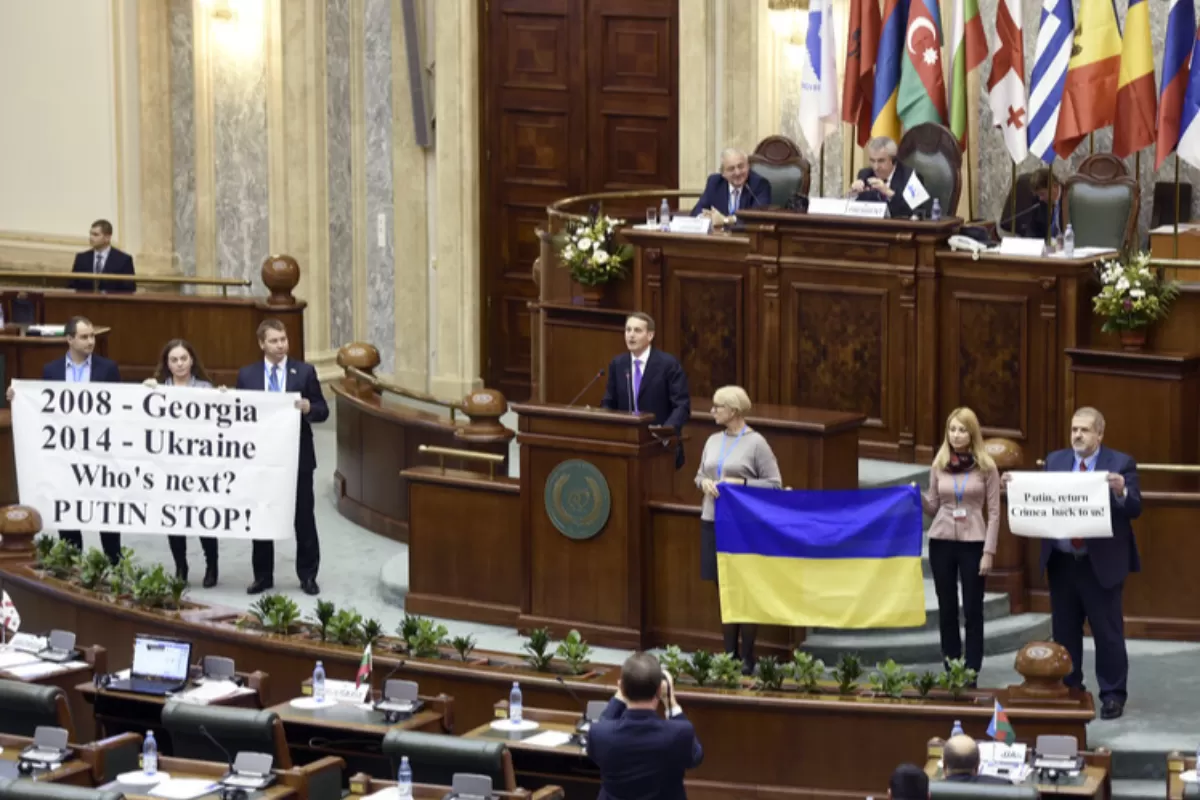
Romania will be partitioned by its neighbors if it decides to fight alongside NATO in a war against Russia. This false narrative was launched on the Romanian media market with a view to eroding public confidence in NATO, and to demonstrate that Russia is not the aggressor in the current crisis in Ukraine.
NEWS: “In the increasingly likely event we will all be forced to go to war alongside NATO against the Russian Federation, and in the even more likely event we will lose the war again, it will be the end of Romania. Hungary will annex Transylvania, Bulgaria will take over Dobruja, Banat will be taken by Serbia whereas Moldovan territories between the Carpathians and the Dniester will unite into a single entity under the authority of the victor. Romania will be reduced to Ilfov and Ialomița counties. Who could possibly want that? Who will be held responsible for such a disaster?”, an article on EvZ.ro reads, quoting a press release of the Union of Ruthenians in Romania.
NARRATIVES: 1. Romania will be torn to pieces by the Russian army in case war breaks out and its territory will be divided between its neighbors. 2. Romania will be dragged into a war in Ukraine. 3. NATO is an organization patterned on Nazi Germany.
BACKGROUND: Against the backdrop of negotiations between the USA and Russia over the demands Moscow submitted on December 17, 2021, to divide Europe in spheres of influence controlled by the West and Russia, and considering Russia’s military build-up on the Ukrainian borders, Moscow has geared up its propaganda machinery to promote the Kremlin’s agenda.
The Russian media describes Ukraine as a country ruled by an extremist Fascist-like government, whereas the West is depicted as an impending threat to Russia’s very existence. Nevertheless, in the last eight years or so, Russia is the one that illegally annexed the Crimean Peninsula, has been supporting pro-Russian separatists in Luhansk and Donetsk in Eastern Ukraine, and at present has mobilized (for the second time in less than a year) a sizable military force close to Ukraine’s borders, which, both Western and Ukrainian officials argue, is evidence pointing to a new invasion.
Russia demands recognition of its superpower status on an equal footing with the USA and China in political and economic terms, although its economic power is actually similar to that of European countries (equal to, if not actually outmatched, by Europe’s strongest economies, and vastly inferior to the economic strength of Europe as a whole).
Moscow is trying to intimidate its opponents by means of its military might and the sheer threat of an imminent war (although officials have repeatedly claimed this is not a scenario they desire).
Therefore, Russia is confident it can keep Ukraine at bay by means of annexations and conflicts on Ukrainian territory, in the hope that developments in this country will run the same course as the conflict in Transnistria.
In July, 1992, as an aggressor and belligerent party to the conflict in Transnistria, Russia managed to secure a peace agreement between the Russian Federation and the Republic of Moldova and to impose a “peacekeeping force” which has since never left Moldova.
In addition to amassing troops on the Ukrainian border, Russia has ramped up its propaganda efforts in an attempt to induce a general war psychosis, particularly in countries in Eastern Europe, specifically those in the first line.
As an important NATO ally on the eastern flank, Romania has also been a constant target of Russian propaganda. Its messages are published not just in Romanian-language publications linked to the Kremlin (sputnik.md), but are also spread via communication/media channels that are largely owned/coordinated by people who’ve had run-ins with the law, more often than not involved in corruption investigations.
The issue of Romania losing Transylvania, just like Ukraine lost Crimea following the latter’s illegal annexation by Russia, is a recurring theme of Russian disinformation which Veridica.ro has dealt with extensively.
This time around, the message is being carried over by the Ruthenian minority in Romania and amplified by Evenimentul Zilei.
Romania is home to 18 national minorities, all represented at Parliament level. Most of the ethnic communities living in Romania show loyalty to the authorities.
The largest minority is obviously the Hungarian one, followed by the Roma and Ukrainian minorities, the latter accounting for a little under 50,000 people, broken down in several subcategories.
Of these, Ruthenians total 2,000 people, according to the 2011 census, certainly not 60,000 as the Union of Ruthenians in Romania claims. The Union is led by Mihai Lauruc, a businessman from Maramureș County who was handed a prison sentence for merchandise fraud and forgery of deeds by private signature. Lauruc is also involved in cigarette trading.
A former boxer, Mihai Lauruc is a close friend of the Russian Embassy in Romania and a regular participant in its official events. Lauruc also attended a series of public events, such as commemorations of the Red Army, of the visit to Bucharest of Patriarch Kirill of Moscow.
Moreover, Romanian MP Iulius Firczak, another representative of the Ruthenian minority in Romania, also posted a reaction on his Facebook page with respect to what he has termed “an attempt to incite and divide the Ruthenian minority”, which is legitimately represented in the Romanian Parliament by the Cultural Union of Ruthenians in Romania, and not by Mihai Lauruc alternative organization.
The leaders of the Alliance for the Union of Romanians (AUR) have also voiced similar themes referring to Romania’s division based on ethnicity.
Furthermore, the idea of Romania being dragged into a conflict that is not its own is one of the favorite themes of Russian propaganda targeting Romania. Veridica.ro has debunked several such articles designed to generate social unrest, claiming Romania will be pushed by the West into a possible war with Ukraine.
PURPOSE: The spread fear at the level of Romanian society by supporting apocalyptic scenarios. To undermine confidence in the EU. To describe Russia as a victim of NATO and not as an aggressor state.
WHY THE NARRATIVES ARE FALSE: The narrative about the risk of Romania being partitioned is a reference to a highly traumatic period in Romanian modern history, when a significant part of Romanian territory was lost (Northern Transylvania was assigned to Hungary under the Second Vienna Award, Northern Bukovina and Bessarabia were transferred to the Soviet Union under the Molotov-Ribbentrop Pact, whereas Southern Dobruja was lost to Bulgaria, after being part of Romania for nearly 30 years).
However, present-day circumstances are completely different. Romania has normalized relations with all its neighbors for decades, and is not currently the object of any territorial claims. Moreover, Romania’s territorial integrity is also warranted under its NATO membership, an Alliance that also includes two of its neighbors, Hungary and Bulgaria. The apocalyptic scenario regarding Romania’s possible disintegration would entail the collapse of the entire post-Cold War security framework in Europe, the breakdown of NATO or (at least) its withdrawal from Eastern Europe, and particularly Russia’s actual capacity to carry out such a far-fetched plan, considering it is vastly overpowered by NATO in economic and military terms.
NATO has repeatedly pointed out it has no intention of getting involved in a military conflict in Ukraine, and that this country is not a NATO Member State, and as such, is not protected under Article 5. Therefore, the only way Romania, as a member of NATO, could be involved in such war is if Russia attacks it or any other ally. In fact, the whole crisis was triggered as a result of Russia mobilizing its troops and threatening to invade an independent country it attacked in the past. In Eastern Europe, Russia has been an aggressor ever since the collapse of the USSR, which had been the main regional aggressor prior to the Russian Federation.
As regards NATO’s comparison with Nazi Germany, NATO is a defensive alliance that poses no threat to Russia. Conversely, Russia is trying to force the hand of Western powers in order to negotiate the fate of Ukraine and other states in Eastern Europe, in a way that recalls negotiations between the Soviet Union and Nazi Germany, dividing independent states in Eastern Europe between themselves and triggering World War II before actually declaring war on each other.
GRAIN OF TRUTH: Romania is home to a large number of ethnic groups.


